Finance Assignment: Interest Compounding, Amortization, and Annuities
VerifiedAdded on 2023/06/15
|7
|1051
|352
Homework Assignment
AI Summary
This assignment delves into the fundamentals of finance, addressing key concepts such as interest compounding, loan amortization, and annuity calculations. It explains the impact of compounding frequency on interest earned or paid, highlighting the preference for monthly compounding for savings and less frequent compounding for loans. The assignment also details the purpose and mechanics of amortization schedules, emphasizing the decreasing interest portion over time and its implications for tax deductions. Furthermore, it differentiates between ordinary annuities and annuities due, illustrating how payment timing affects future value. Numerical examples are provided to demonstrate the effects of varying interest rates on future and present values of annuities. Desklib offers comprehensive study tools and resources for students seeking a deeper understanding of these financial principles.

Running head: FUNDAMENTALS OF FINANCE
Fundamentals of Finance
Name of the Student:
Name of the University:
Author’s Note:
Fundamentals of Finance
Name of the Student:
Name of the University:
Author’s Note:
Paraphrase This Document
Need a fresh take? Get an instant paraphrase of this document with our AI Paraphraser
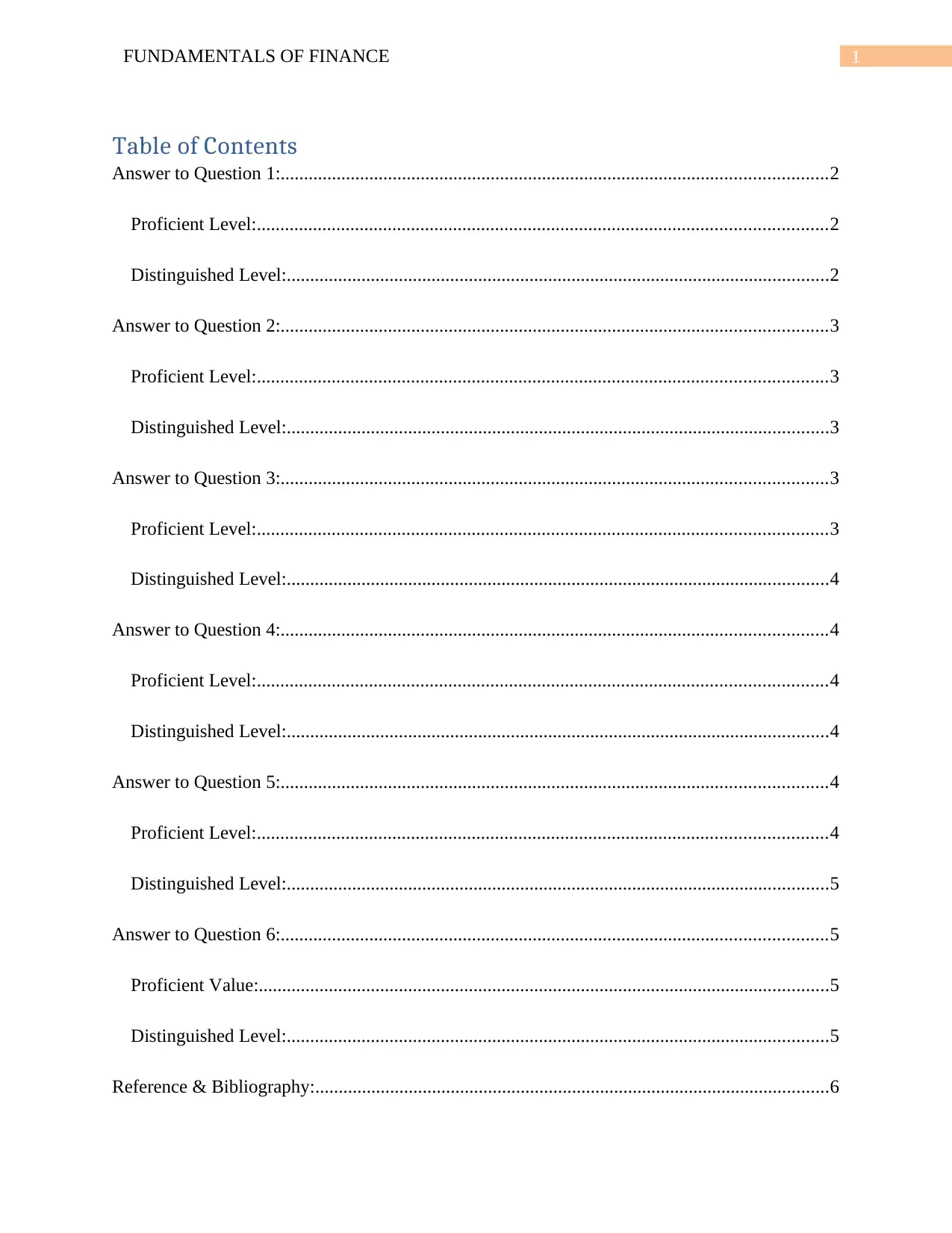
1FUNDAMENTALS OF FINANCE
Table of Contents
Answer to Question 1:.....................................................................................................................2
Proficient Level:..........................................................................................................................2
Distinguished Level:....................................................................................................................2
Answer to Question 2:.....................................................................................................................3
Proficient Level:..........................................................................................................................3
Distinguished Level:....................................................................................................................3
Answer to Question 3:.....................................................................................................................3
Proficient Level:..........................................................................................................................3
Distinguished Level:....................................................................................................................4
Answer to Question 4:.....................................................................................................................4
Proficient Level:..........................................................................................................................4
Distinguished Level:....................................................................................................................4
Answer to Question 5:.....................................................................................................................4
Proficient Level:..........................................................................................................................4
Distinguished Level:....................................................................................................................5
Answer to Question 6:.....................................................................................................................5
Proficient Value:..........................................................................................................................5
Distinguished Level:....................................................................................................................5
Reference & Bibliography:..............................................................................................................6
Table of Contents
Answer to Question 1:.....................................................................................................................2
Proficient Level:..........................................................................................................................2
Distinguished Level:....................................................................................................................2
Answer to Question 2:.....................................................................................................................3
Proficient Level:..........................................................................................................................3
Distinguished Level:....................................................................................................................3
Answer to Question 3:.....................................................................................................................3
Proficient Level:..........................................................................................................................3
Distinguished Level:....................................................................................................................4
Answer to Question 4:.....................................................................................................................4
Proficient Level:..........................................................................................................................4
Distinguished Level:....................................................................................................................4
Answer to Question 5:.....................................................................................................................4
Proficient Level:..........................................................................................................................4
Distinguished Level:....................................................................................................................5
Answer to Question 6:.....................................................................................................................5
Proficient Value:..........................................................................................................................5
Distinguished Level:....................................................................................................................5
Reference & Bibliography:..............................................................................................................6
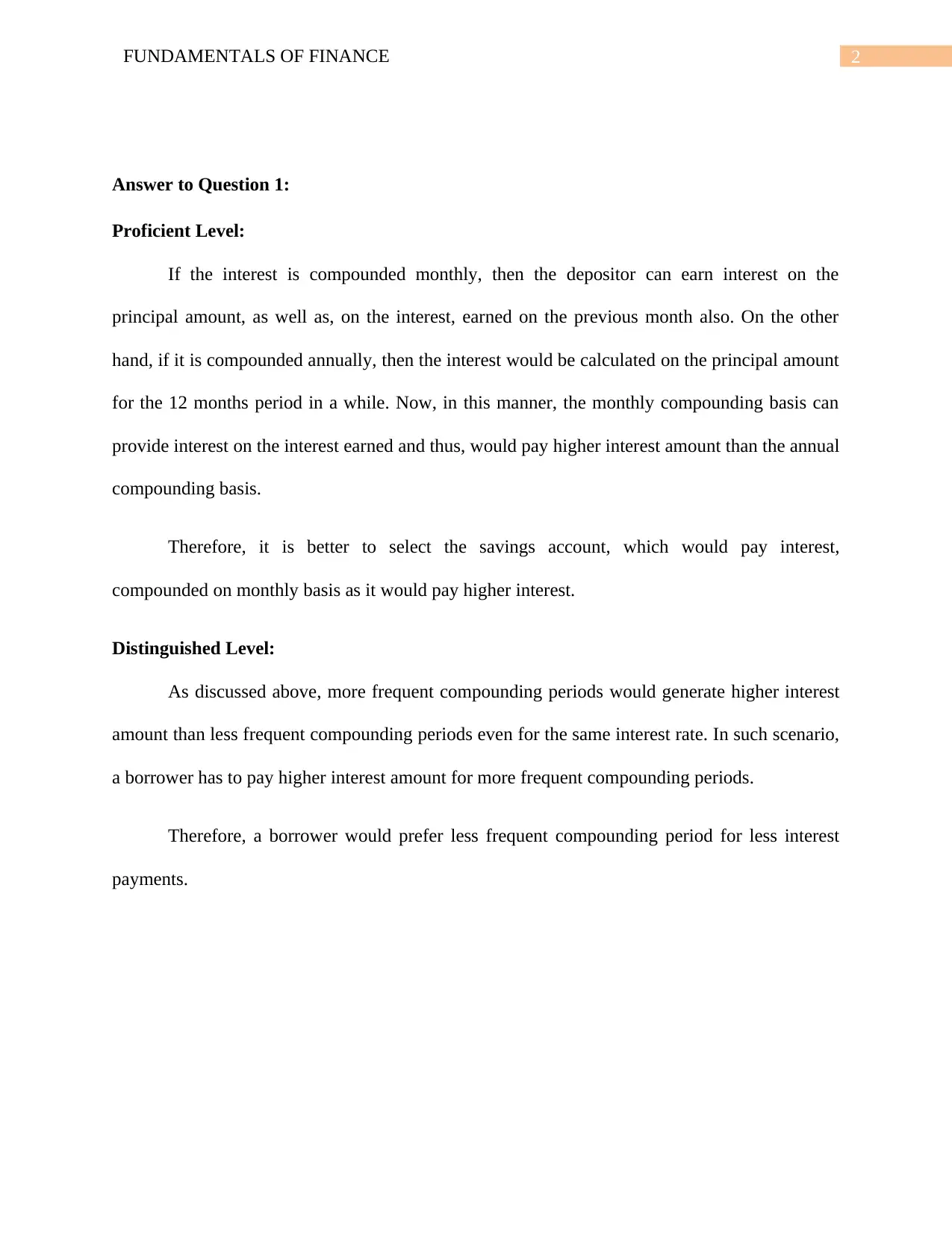
2FUNDAMENTALS OF FINANCE
Answer to Question 1:
Proficient Level:
If the interest is compounded monthly, then the depositor can earn interest on the
principal amount, as well as, on the interest, earned on the previous month also. On the other
hand, if it is compounded annually, then the interest would be calculated on the principal amount
for the 12 months period in a while. Now, in this manner, the monthly compounding basis can
provide interest on the interest earned and thus, would pay higher interest amount than the annual
compounding basis.
Therefore, it is better to select the savings account, which would pay interest,
compounded on monthly basis as it would pay higher interest.
Distinguished Level:
As discussed above, more frequent compounding periods would generate higher interest
amount than less frequent compounding periods even for the same interest rate. In such scenario,
a borrower has to pay higher interest amount for more frequent compounding periods.
Therefore, a borrower would prefer less frequent compounding period for less interest
payments.
Answer to Question 1:
Proficient Level:
If the interest is compounded monthly, then the depositor can earn interest on the
principal amount, as well as, on the interest, earned on the previous month also. On the other
hand, if it is compounded annually, then the interest would be calculated on the principal amount
for the 12 months period in a while. Now, in this manner, the monthly compounding basis can
provide interest on the interest earned and thus, would pay higher interest amount than the annual
compounding basis.
Therefore, it is better to select the savings account, which would pay interest,
compounded on monthly basis as it would pay higher interest.
Distinguished Level:
As discussed above, more frequent compounding periods would generate higher interest
amount than less frequent compounding periods even for the same interest rate. In such scenario,
a borrower has to pay higher interest amount for more frequent compounding periods.
Therefore, a borrower would prefer less frequent compounding period for less interest
payments.
⊘ This is a preview!⊘
Do you want full access?
Subscribe today to unlock all pages.

Trusted by 1+ million students worldwide
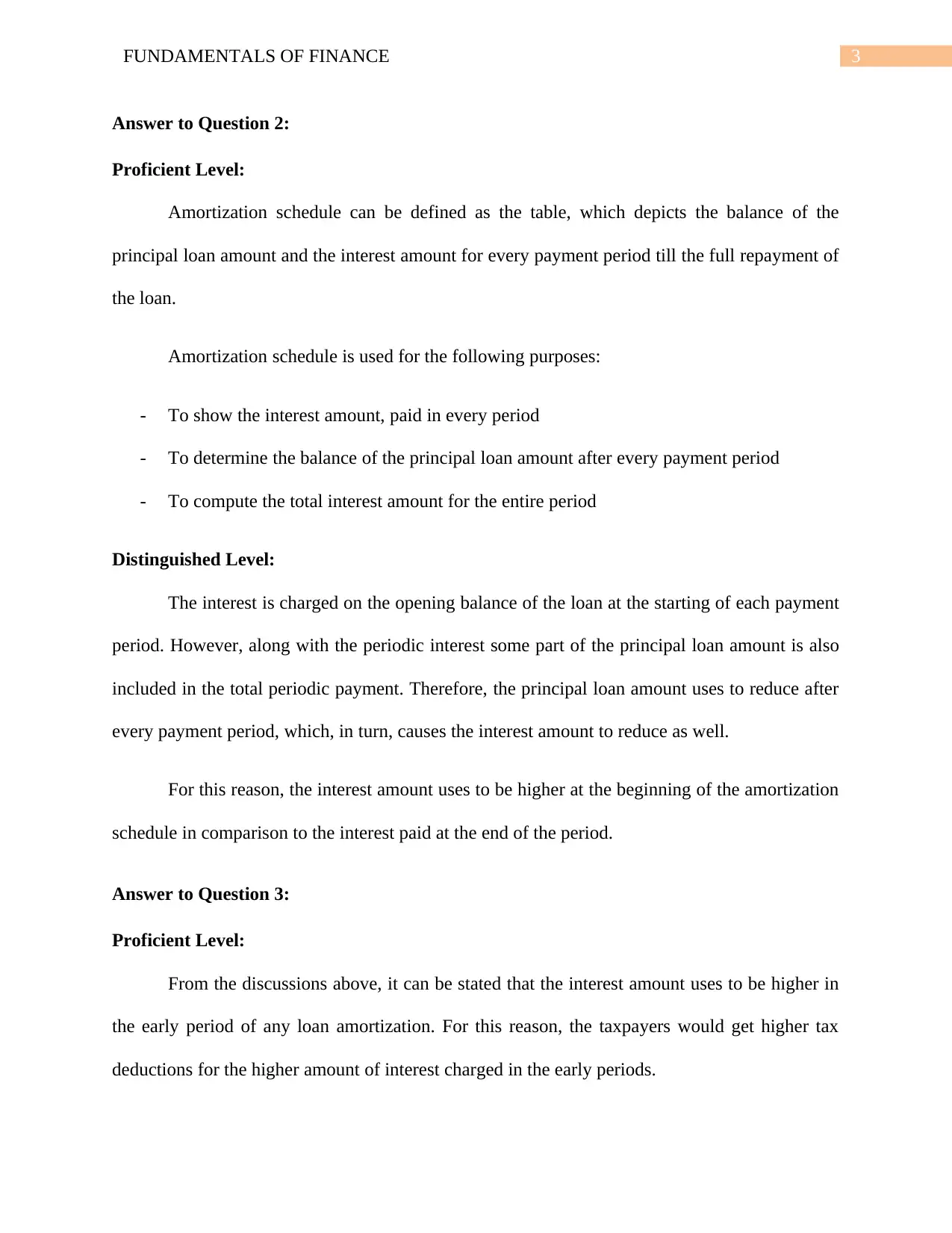
3FUNDAMENTALS OF FINANCE
Answer to Question 2:
Proficient Level:
Amortization schedule can be defined as the table, which depicts the balance of the
principal loan amount and the interest amount for every payment period till the full repayment of
the loan.
Amortization schedule is used for the following purposes:
- To show the interest amount, paid in every period
- To determine the balance of the principal loan amount after every payment period
- To compute the total interest amount for the entire period
Distinguished Level:
The interest is charged on the opening balance of the loan at the starting of each payment
period. However, along with the periodic interest some part of the principal loan amount is also
included in the total periodic payment. Therefore, the principal loan amount uses to reduce after
every payment period, which, in turn, causes the interest amount to reduce as well.
For this reason, the interest amount uses to be higher at the beginning of the amortization
schedule in comparison to the interest paid at the end of the period.
Answer to Question 3:
Proficient Level:
From the discussions above, it can be stated that the interest amount uses to be higher in
the early period of any loan amortization. For this reason, the taxpayers would get higher tax
deductions for the higher amount of interest charged in the early periods.
Answer to Question 2:
Proficient Level:
Amortization schedule can be defined as the table, which depicts the balance of the
principal loan amount and the interest amount for every payment period till the full repayment of
the loan.
Amortization schedule is used for the following purposes:
- To show the interest amount, paid in every period
- To determine the balance of the principal loan amount after every payment period
- To compute the total interest amount for the entire period
Distinguished Level:
The interest is charged on the opening balance of the loan at the starting of each payment
period. However, along with the periodic interest some part of the principal loan amount is also
included in the total periodic payment. Therefore, the principal loan amount uses to reduce after
every payment period, which, in turn, causes the interest amount to reduce as well.
For this reason, the interest amount uses to be higher at the beginning of the amortization
schedule in comparison to the interest paid at the end of the period.
Answer to Question 3:
Proficient Level:
From the discussions above, it can be stated that the interest amount uses to be higher in
the early period of any loan amortization. For this reason, the taxpayers would get higher tax
deductions for the higher amount of interest charged in the early periods.
Paraphrase This Document
Need a fresh take? Get an instant paraphrase of this document with our AI Paraphraser
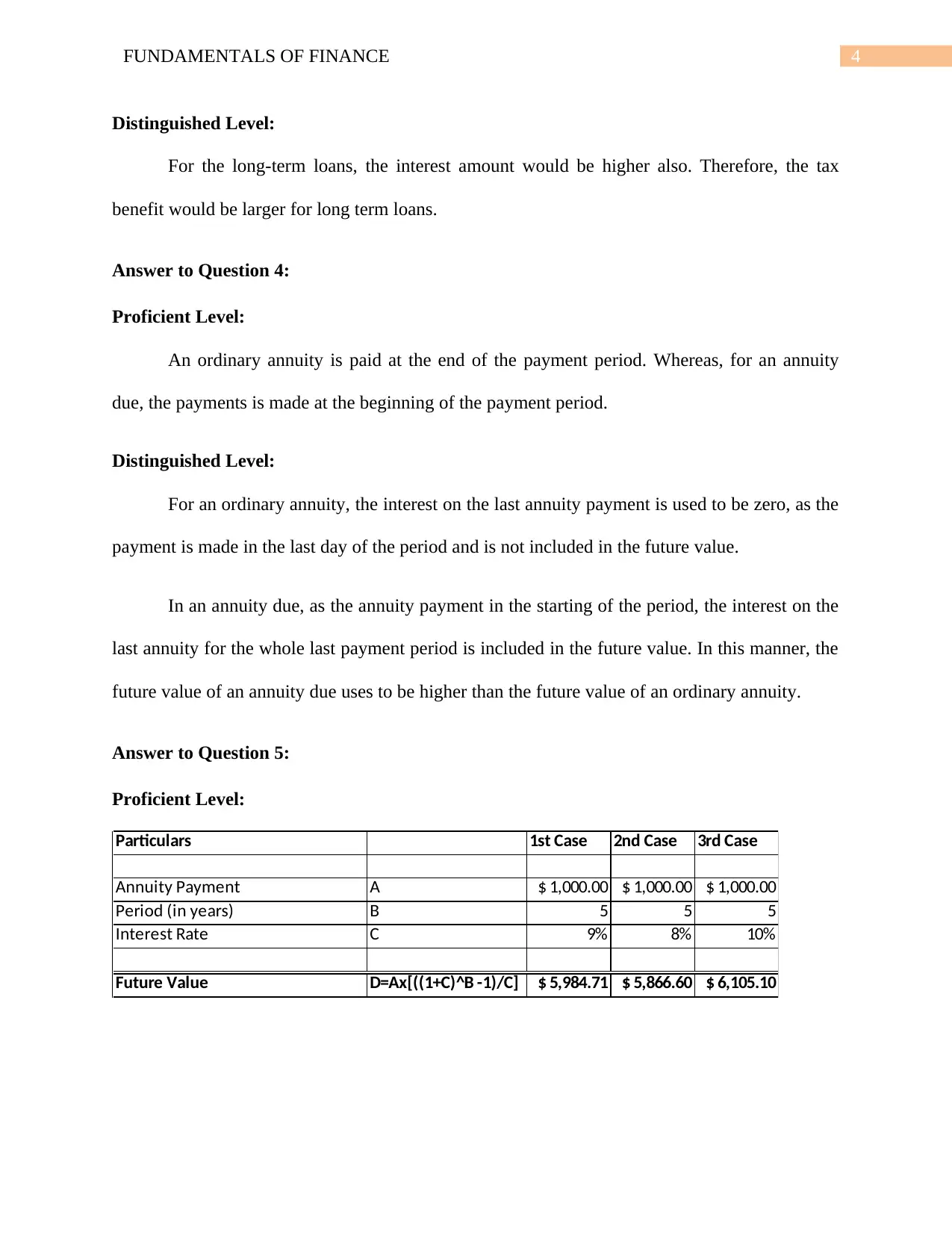
4FUNDAMENTALS OF FINANCE
Distinguished Level:
For the long-term loans, the interest amount would be higher also. Therefore, the tax
benefit would be larger for long term loans.
Answer to Question 4:
Proficient Level:
An ordinary annuity is paid at the end of the payment period. Whereas, for an annuity
due, the payments is made at the beginning of the payment period.
Distinguished Level:
For an ordinary annuity, the interest on the last annuity payment is used to be zero, as the
payment is made in the last day of the period and is not included in the future value.
In an annuity due, as the annuity payment in the starting of the period, the interest on the
last annuity for the whole last payment period is included in the future value. In this manner, the
future value of an annuity due uses to be higher than the future value of an ordinary annuity.
Answer to Question 5:
Proficient Level:
Particulars 1st Case 2nd Case 3rd Case
Annuity Payment A $ 1,000.00 $ 1,000.00 $ 1,000.00
Period (in years) B 5 5 5
Interest Rate C 9% 8% 10%
Future Value D=Ax[((1+C)^B -1)/C] $ 5,984.71 $ 5,866.60 $ 6,105.10
Distinguished Level:
For the long-term loans, the interest amount would be higher also. Therefore, the tax
benefit would be larger for long term loans.
Answer to Question 4:
Proficient Level:
An ordinary annuity is paid at the end of the payment period. Whereas, for an annuity
due, the payments is made at the beginning of the payment period.
Distinguished Level:
For an ordinary annuity, the interest on the last annuity payment is used to be zero, as the
payment is made in the last day of the period and is not included in the future value.
In an annuity due, as the annuity payment in the starting of the period, the interest on the
last annuity for the whole last payment period is included in the future value. In this manner, the
future value of an annuity due uses to be higher than the future value of an ordinary annuity.
Answer to Question 5:
Proficient Level:
Particulars 1st Case 2nd Case 3rd Case
Annuity Payment A $ 1,000.00 $ 1,000.00 $ 1,000.00
Period (in years) B 5 5 5
Interest Rate C 9% 8% 10%
Future Value D=Ax[((1+C)^B -1)/C] $ 5,984.71 $ 5,866.60 $ 6,105.10
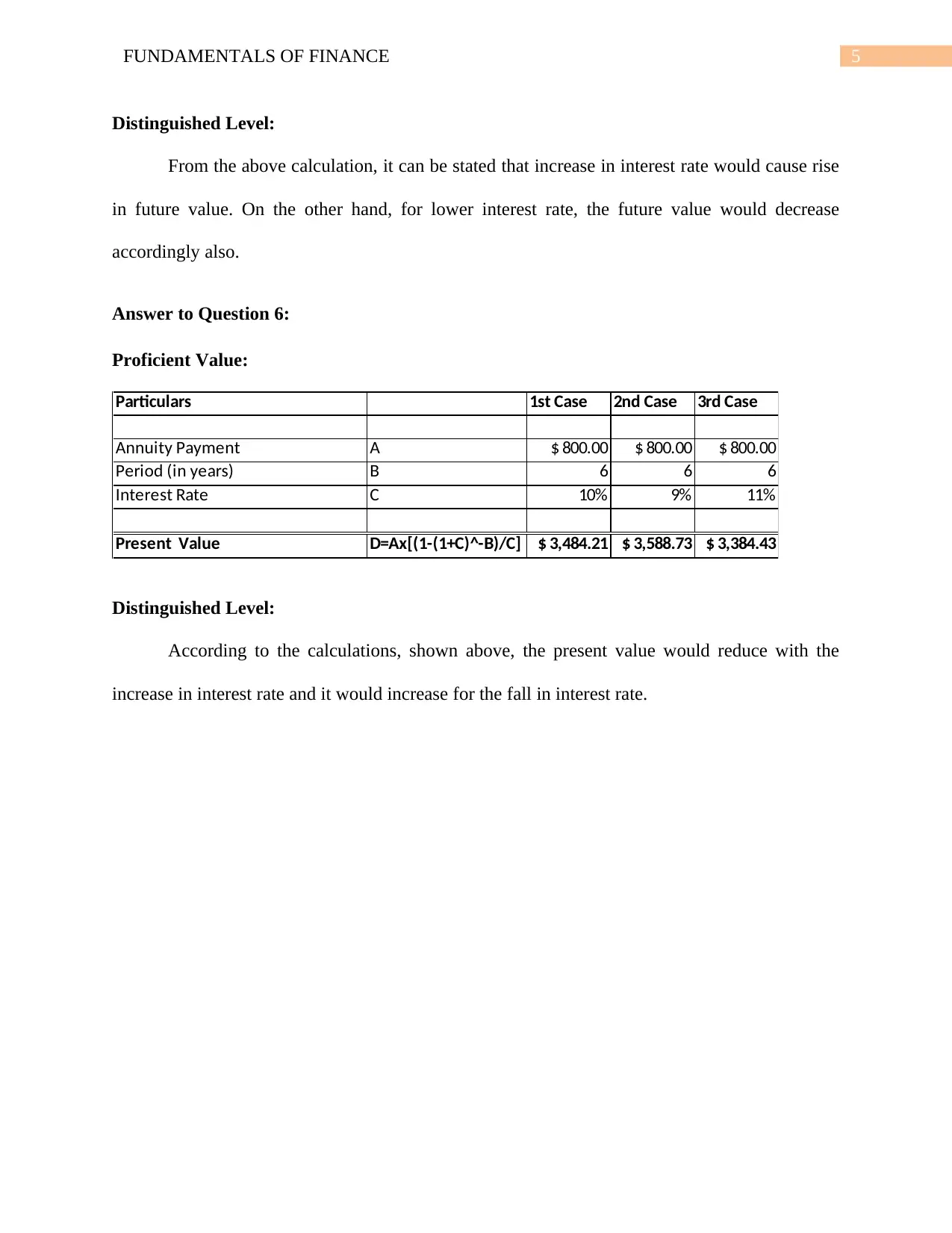
5FUNDAMENTALS OF FINANCE
Distinguished Level:
From the above calculation, it can be stated that increase in interest rate would cause rise
in future value. On the other hand, for lower interest rate, the future value would decrease
accordingly also.
Answer to Question 6:
Proficient Value:
Particulars 1st Case 2nd Case 3rd Case
Annuity Payment A $ 800.00 $ 800.00 $ 800.00
Period (in years) B 6 6 6
Interest Rate C 10% 9% 11%
Present Value D=Ax[(1-(1+C)^-B)/C] $ 3,484.21 $ 3,588.73 $ 3,384.43
Distinguished Level:
According to the calculations, shown above, the present value would reduce with the
increase in interest rate and it would increase for the fall in interest rate.
Distinguished Level:
From the above calculation, it can be stated that increase in interest rate would cause rise
in future value. On the other hand, for lower interest rate, the future value would decrease
accordingly also.
Answer to Question 6:
Proficient Value:
Particulars 1st Case 2nd Case 3rd Case
Annuity Payment A $ 800.00 $ 800.00 $ 800.00
Period (in years) B 6 6 6
Interest Rate C 10% 9% 11%
Present Value D=Ax[(1-(1+C)^-B)/C] $ 3,484.21 $ 3,588.73 $ 3,384.43
Distinguished Level:
According to the calculations, shown above, the present value would reduce with the
increase in interest rate and it would increase for the fall in interest rate.
⊘ This is a preview!⊘
Do you want full access?
Subscribe today to unlock all pages.

Trusted by 1+ million students worldwide
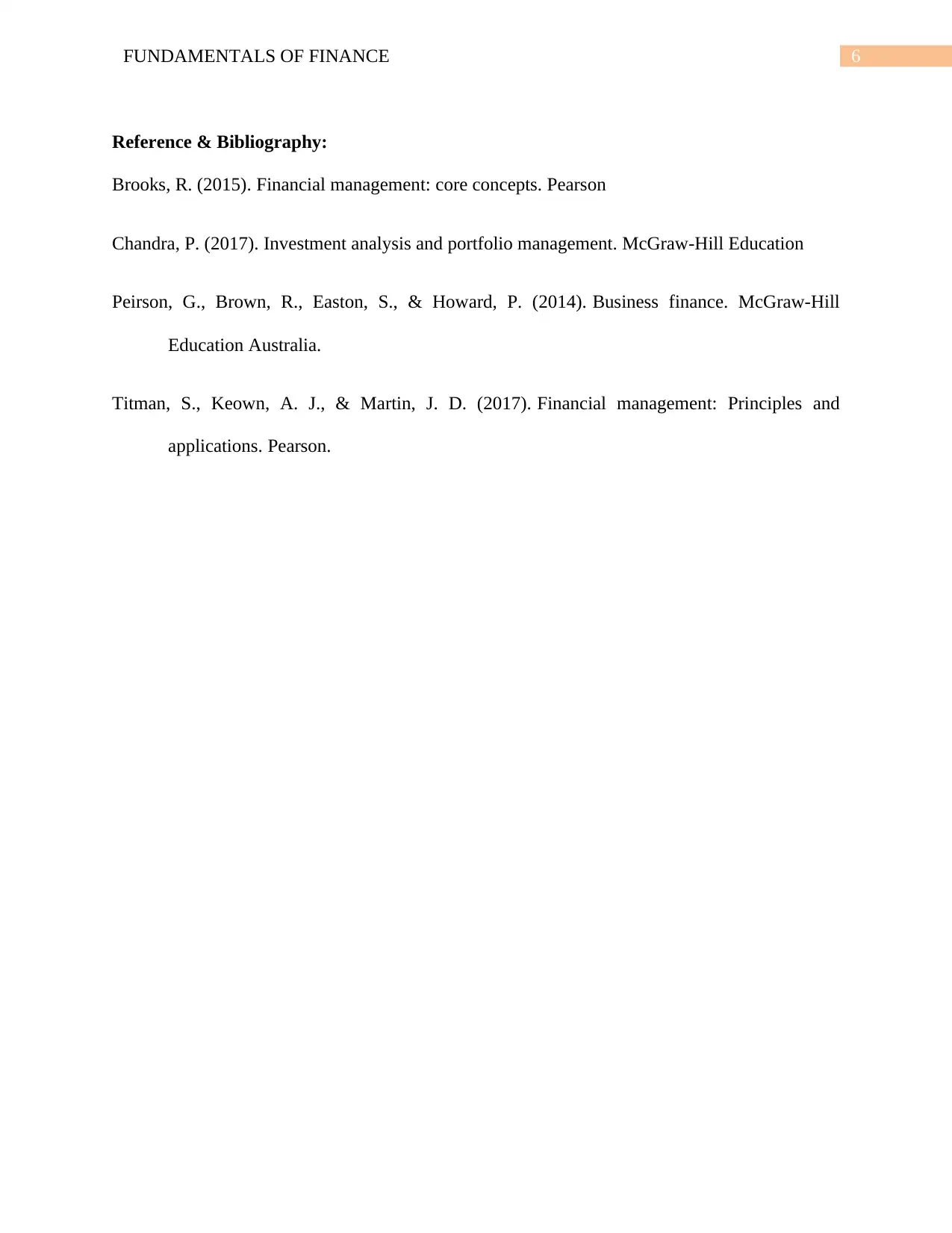
6FUNDAMENTALS OF FINANCE
Reference & Bibliography:
Brooks, R. (2015). Financial management: core concepts. Pearson
Chandra, P. (2017). Investment analysis and portfolio management. McGraw-Hill Education
Peirson, G., Brown, R., Easton, S., & Howard, P. (2014). Business finance. McGraw-Hill
Education Australia.
Titman, S., Keown, A. J., & Martin, J. D. (2017). Financial management: Principles and
applications. Pearson.
Reference & Bibliography:
Brooks, R. (2015). Financial management: core concepts. Pearson
Chandra, P. (2017). Investment analysis and portfolio management. McGraw-Hill Education
Peirson, G., Brown, R., Easton, S., & Howard, P. (2014). Business finance. McGraw-Hill
Education Australia.
Titman, S., Keown, A. J., & Martin, J. D. (2017). Financial management: Principles and
applications. Pearson.
1 out of 7
Related Documents
Your All-in-One AI-Powered Toolkit for Academic Success.
+13062052269
info@desklib.com
Available 24*7 on WhatsApp / Email
![[object Object]](/_next/static/media/star-bottom.7253800d.svg)
Unlock your academic potential
Copyright © 2020–2025 A2Z Services. All Rights Reserved. Developed and managed by ZUCOL.




